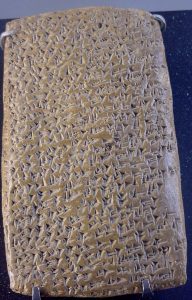
Ancient economy: a bone sickle – the flint teeth are missing now
Trade or self-sufficiency?
Even today experts don’t really understand how economics works. Historians also disagree about how economics worked in antiquity and in the middle ages. Some historians think that long ago most people were self-sufficient. They ate and wore mostly what they produced themselves on their own farms.
Other historians think that most people traded for what they needed, or bought it at the store, as people do today. Certainly some people produced some things at home, and some people bought some things at the store. It is hard to say where the balance really was between these two ways of living.
Trade in the Stone Age
Stone Age people were probably more on the side of self-sufficiency. People grew, hunted, or gathered their own food, for the most part, and they made their own clothes. But even in the Stone Age there was some trading, for obsidian and basalt grindstones for instance.
Trade in the Bronze Age
The coming of the Bronze Age in itself helped to increase trade, because in order to make bronze you had to have tin, and tin was not available everywhere. You had to trade for it. People started to trade more in this period, not just for tin but also for spices, lumber, furs, and other things. Also, some farmers traded with nomad shepherds, trading the grain (and beer) and vegetables the farmers grew for the mutton (sheep meat) and cheese and wool that the shepherds had.

Ancient economy: Cuneiform tablet from West Asia
In China, on the other hand, people seem to have been experimenting with bronze money by about 1700 BC.
Taxation and tithes
As people began to live in cities and have kings, too, we can see the beginnings of taxation (forced payments to the king) and tithes (forced payments to the gods, or to the priests). In this period a lot of the taxes and tithes were in the form of so many days of work per person. Each man had to go work for the government a few days each month. Already in this period, thanks to the invention of writing, people in West Asia were using checks to pay their bills: they sent a letter saying that they owed a certain person so much stuff, and later the person could come claim it from them.
Economic crisis: the end of the Bronze Age
In the Dark Age at the end of the Bronze Age, both governments and trade in Europe and West Asia seem to have fallen apart for a while, and people went back to being mostly self-sufficient. This may be the first big economic crisis known to historians, if indeed it was caused by economic factors and not by political ones. Self-sufficiency turned out not to be so good for people, in any case: the standard of living fell dramatically when people stopped cooperating with each other economically.

A Lydian gold coin
Iron Age trade
After the Dark Age, around 900 BC, trade started up again in a big way. In the Mediterranean, first the Phoenicians and then the Greeks and Carthaginians dominated trade. In West Asia, the Assyrians and the Arabs were the big traders, and later on the Persians, who were the first to build good paved roads throughout West Asia. In West Asia, during this period, people were using money, in the form of gold and silver coins.
Learn by doing: making Greek coins
More about the medieval economy
Bibliography and further reading about the ancient economy:
Eyewitness: Money, by Joe Cribb (2000). Not the best in the series, but still a good introduction to exchange systems for kids.
The Roman Empire: Economy, Society and Culture, by Peter Garnsey and Richard Saller (1987). Two experts, but their writing is easy enough for high schoolers.
Rural Economy and Country Life in the Medieval West, by Georges Duby (reprinted 1998). Translated from French. A path-breaking account of what it was like to be a medieval peasant, though it can be hard to read.



